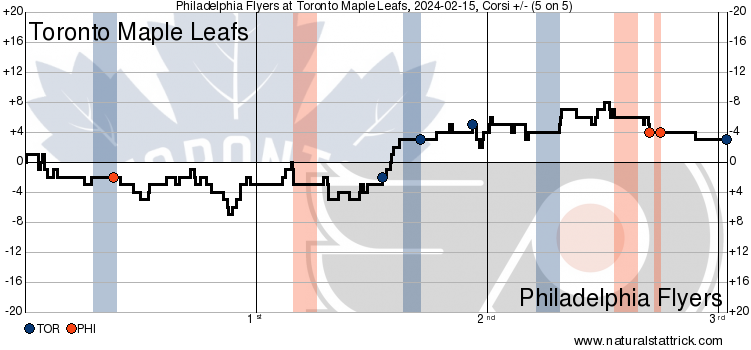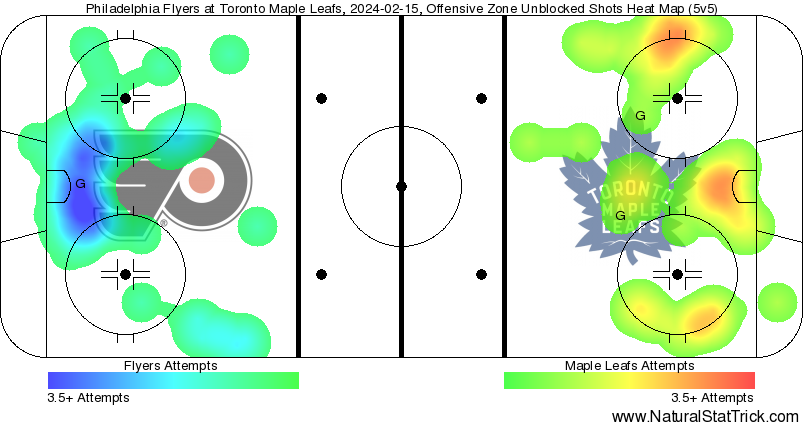Auston Matthews scored a second-period natural hat trick, but a late third-period collapse meant the Toronto Maple Leafs needed William Nylander’s OT goal to defeat the Philadelphia Flyers 4-3 on Thursday night.
A sleepy first half of the game for Toronto gave way to a second-period explosion in which Matthews collected his natural hat trick in a span of about eight minutes. The Maple Leafs protected the lead well until a run of bad offensive-zone penalties put them behind the eight ball and resulted in Philadelphia’s equalizer. The OT didn’t last long, though, as Nylander’s goal sent the fans home happy.
Your game in 10:
1. There weren’t many whistles in the first seven or so minutes of this game, with one of the only stoppages coming when a Toronto forecheck helped induce a delay of game penalty by Sean Walker. The Leafs went to the power play and showcased a different look than the one they showcased on Tuesday. With Rielly still suspended, Toronto put Timothy Liljegren at the point on the top unit instead of Jake McCabe.
The power play was awful, which probably set the tone for the Leafs‘ first period at large. The first unit lost the opening draw and struggled to break the zone for most of the shift before disaster struck for the second unit.
Off the entry, Max Domi didn’t chip the puck down the wall to Tyler Bertuzzi and instead curled up high in the zone and attempted to evade the tight-checking pressure of multiple Flyers. With Domi in a tight spot high in the zone, Mark Giordano slid inside the blue line toward the wall looking to provide a support outlet, but he ended up so close to Domi that they could almost hug each other, which pretty much took him out of the play once Domi was stripped of the puck.
After the turnover, Travis Konecny had nothing but open ice to break in all alone on Ilya Samsonov, who he beat with his shot but rang the puck off the iron in the process. Even after a lucky break bailed them out, it actually got worse for the Leafs‘ PP.
The puck went into the corner, where Konecny chased down his own rebound and took it up the wall away from the Leaf net, where he was met by a nice hit from Matthew Knies. Domi was in pursuit of Konecny up the wall at the time of the hit and erred on the side of jumping for a fast break rather than securing possession of the puck. Scott Laughton arrived on the loose puck first, and Giordano left the front of the net to close down on a pass that easily went through to Travis Sanheim, who was all alone in front to beat Samsonov with a deke.
It was Philadelphia’s 13th short-handed goal of the season, the most in the NHL. From the Leafs‘ perspective, though, this was a comedy of errors. It was certainly not the kind of shift that is going to earn the second unit more trust, although the first unit wasn’t at all sharp early, either.
2. For the rest of the opening frame, the Leafs struggled to get anything going. Philadelphia’s disciplined and structured neutral zone play bogged down Toronto’s transition game, choking off controlled entries and giving them issues recovering the dump-ins.
The Flyers continued to look faster across the 200 feet of ice as well as stronger on the walls. The Leafs weren’t winning many battles and therefore didn’t create much of anything offensively. They generated only two high-danger chances in 18 minutes of 5v5 play in the first period, according to Natural Stat Trick, and it translated to only 0.35 expected goals.
Add in a brutal power play that saw them concede a shorthanded goal, and it was a pretty rotten opening stanza. If you were hoping to see the Leafs build on their terrific effort on Tuesday night against St. Louis after gaining a couple of star players back in the lineup, this first period fell well short of expectations.
3. The second period began at 4v4 because of a post-horn scrum to end the first period. Bobby McMann and Nick Seeler ended up tied up in the scrum, while Simon Benoit and John Tavares played roles in it as well. Not much happened in the 4v4, but Max Domi intercepted a puck shortly after it expired and opted not to shoot it, waiting and waiting for a passing lane that he eventually couldn’t connect on. McCabe then hooked Owen Tippett after turning the puck over near his own net, sending the Leafs to the PK for the first time in the game.
Contrary to their PK, Philadelphia’s PP has struggled this season as one of the worst in the NHL. They didn’t create a ton on this one but did set up one good look for Morgan Frost in the slot, which Ilya Samsonov kicked out with a stellar toe save.
That kept the score 1-0 and play returned to five aside, but as the clock approached the halfway point of the second period (and game), there wasn’t much of a concerted push made by Toronto. From Philly’s perspective, the game was satisfactorily boring.
4. The breath of life the Leafs needed came from the best player on either team, Auston Matthews. After a more muted performance on Tuesday night (by his standards) while the depth players shined, Matthews used the remainder of the second period to put his stamp on the contest, completely flipping the script and the feel of the game. What was once a sleepy, listless effort from the home side was turned on its head thanks to Matthews’ otherworldly wrist shot.
#34’s first goal was created by his linemate Mitch Marner, who played good situational hockey by recognizing that Philadelphia was going for the long change in the second period. With Marc Staal trying to sneak off the ice, the neutral zone that Toronto was struggling to penetrate was suddenly wide open. Marner tracked back, timed it up perfectly, and then whipped a stretch pass up the ice to Matthews.
Matthews had the space to walk in and uncork his patented wrist shot right over the glove of Samuel Ersson. Superstars can reverse the course of a game in the blink of an eye, and the Leafs are very fortunate to have a couple of them.
5. As can often happen in hockey, one goal flipped the momentum. Suddenly the Leafs had energy in their legs and were able to string together productive offensive shifts. When the second line took the ice, William Nylander created an A+ scoring chance for Tyler Bertuzzi that — like so many chances he’s gotten in the past few weeks — he did nothing with.
The blown chance for Bertuzzi didn’t faze the Leafs as the next Tavares line shift was electric as well and the Flyers were now on their heels. Fast forward a few minutes, the Leafs went on the power play after Owen Tippett was called for an interference.
This second power play went much better than the first one in the end, although it flirted with disaster again. A zone entry went haywire and gifted Travis Konecny another shorthanded rush chance, this one a 2v1. The Flyer forward couldn’t convert on the opportunity, and the Leafs took it back the other way. Once in the offensive zone, Marner teed up Matthews from the wing and #34 blew it by Ersson again to give Toronto the lead.
Two goals in just under 3.5 minutes, with this one beating the goalie to the near post. 2-1 Leafs.
6. Matthews was in a groove now. On his next shift at 5v5, Matthews hopped on a loose puck, drove to the net, and nearly scored. And then he completed a hat trick in eight minutes.
When the Flyers tried to clear the puck, Timothy Liljegren did well to hold the line, knocking the puck down with his glove. Matthews was clever not to touch the puck in order to avoid the hand pass before Liljegren jumped back on it and threaded a nice pass over to Matthews, who took a couple of strides and then ripped the puck by Ersson, yet again targeting the glove side.
"HOLY MACKINAW!"
MATTHEWS HAT TRICK GOAL vs Philadelphia Flyers courtesy of Joe Bowen and Jim Ralph. #LeafsForever @Bonsie1951 @Jim_Ralph
2/15/2024 pic.twitter.com/FWOWcLgkgx
— Maple Leafs Hotstove (@LeafsNews) February 16, 2024
Matthews’ third goal of the period gave him his 45th in 51 games played this season. If he can sustain this pace over the team’s final 30 games of the season, he would end the season with 71 goals. No NHL player has cracked the 70+ goal mark since Teemu Selanne and Alexander Mogilny did it in the 1992-93 NHL season. Jaw-dropping stuff.
7. The Leafs were now up 3-1 and had all the energy late in the second period, but they nearly gave one right back. TJ Brodie failed to get a puck out — turning it over in his own end on the exit — and then let the play get by him, creating an abbreviated 3v1 in tight for the Flyers.
Philly was unable to finish the first or second chance off, in part due to stellar goaltending from Ilya Samsonov, but it was flirting with disaster for the Leafs. Samsonov’s movements in the net continue to be rather busy at times, but he’s mostly getting results right now. Since returning from the mental reset, Samsonov is 6-2 with a .917 SV%, much more in line with what we saw last season.
After dodging a bullet, the third period was reasonably smooth for the Leafs for the first 12 or so minutes. Bobby McMann got a good chance off a drive to the net that he just couldn’t tuck inside the back post. Simon Benoit popped Cam York and then fought Nick Deslauriers, who was handed an instigator call, sending the Leafs to their third power play.
Benoit continues to bring a high level of punishing physicality that helps turn game momentum in his team’s favour without costing them the other way discipline-wise. It led to probably Toronto’s most consistent PP — and the first one where they didn’t cede a dangerous shorthanded chance — but despite the good looks, they couldn’t score a goal.
Pontus Holmberg set up Nick Robertson for a quality look, but Ersson made the save. Neither team could get on the board, but more importantly, valuable time was ticking away from Philadelphia.
8. The Leafs let the Flyers back in the game tonight because of dumb penalties away from the play. The first one was on Noah Gregor with just under nine minutes to play, a roughing call from an altercation in the offensive zone. It was a marginal call — likely an attempt by referees to balance the calls and give Philly one more PP opportunity (at the time. PPs were 3-1 Toronto) — but it presented an opportunity to flip the momentum of the game. The Leafs actually killed it off, with a nice shot block from Mark Giordano and a sweet glove stop by Samsonov on Travis Sanheim standing out as the highlights.
However, not long after the penalty expired, the Flyers got the goal they needed. Matthew Knies attempted to one-arm a puck by Seeler up the wall in the defensive zone rather than making sure it got out. Having won the initial race to the puck, Knies needed to use his body effectively there to block out Seeler and get the puck into a safe spot. Especially considering time/place/game situation, it is another learning lesson for Knies on the breakout.
With the puck still in the zone, a scrum on the wall unfolded, Domi and Lagesson couldn’t come up with it as the Flyers won the puck battle and worked it to the point. Samsonov made the initial save, but Garnet Hathaway tapped in the rebound after gaining some separation on Timothy Liljegren in front. 3-2 Leafs with 5:46 remaining.
9. With the Leafs’ lead halved with five minutes to go, this could be categorized as just about the worst time possible for a bad offensive-zone penalty. Less than 30 seconds after Philly’s second goal, Tyler Bertuzzi took a tripping penalty in the offensive zone. Needless to say, for a player who is struggling to score, the last thing Bertuzzi can be doing is taking untimely penalties like this.
Philadephia’s subpar power play took the ice for the third opportunity of the night, and this time they had a pep in their step. The Flyers moved the puck down initially for a tip play at the side of the net, where a mass of bodies congregated for a subsequent loose puck battle. The Leafs couldn’t find it before Owen Tippett worked it over to Travis Konecny walking down the backside, where the winger wired a shot into the exposed net, giving Samsonov little chance.
10. With only 4:45 left in the game at the time of the equalizer, both teams were able to create an opportunity to score and win it in regulation. Philadelphia’s best opportunity was nullified when Konecny’s breakaway came in just offsides, while Toronto’s best opportunity was turned aside by Samuel Ersson despite the efforts of Matthews, Marner, and Brodie.
The game went into overtime, where Sheldon Keefe started Auston Matthews, Mitch Marner, and Jake McCabe for the first shift. Matthews won the opening faceoff, and the trio did a good job of managing the puck and retaining possession even if they didn’t create anything; they also didn’t overextend their shift, getting off the ice at the 40-second mark with the puck in a good spot for the next group coming on the ice.
Timothy Liljegren — who had a generally strong game and played a whopping 24:25(!) — brought the puck into the offensive zone and drew in pressure from the Flyers skaters before slipping the pass over to William Nylander, who did the rest.
Nylander took the pass and made up for what had been a rather quiet night by ripping this one through Ersson to end it. A slight hesitation after catching the pass opened the goalie up, and Nylander found a hole to grab the extra point for the Leafs.
NYLANDER OT WINNER vs Philadelphia Flyers courtesy of Joe Bowen and Jim Ralph. #LeafsForever @Bonsie1951 @Jim_Ralph
2/15/2024 pic.twitter.com/g4SeIy3nC5
— Maple Leafs Hotstove (@LeafsNews) February 16, 2024
Overall, it was a mixed performance from the Leafs and yet another example of how it pays to have difference-making superstars.
Game Flow: 5v5 Shot Attempts
Heat Map: 5v5 Shot Attempts



































![New Leaf Anthony Stolarz on the opportunity in Toronto: “In Florida, I knew my role as a backup… Now, [Joseph Woll] and I are competing for starts… As a goalie, that’s all you can ask for” Anthony Stolarz, Stanley Cup win, now Maple Leaf](https://mapleleafshotstove.com/wp-content/uploads/2024/07/anthony-stolarz-sc-100x70.jpg)
